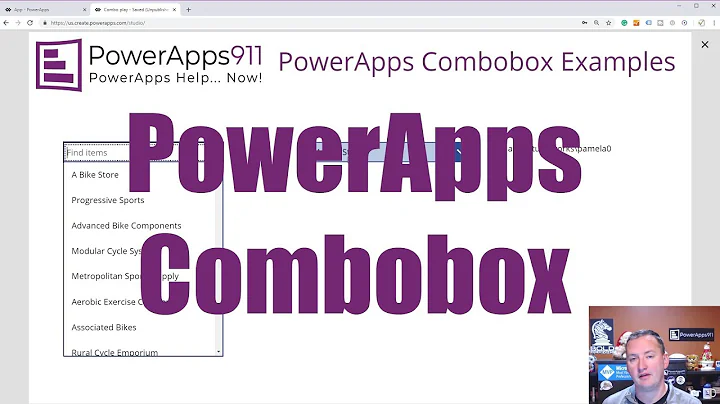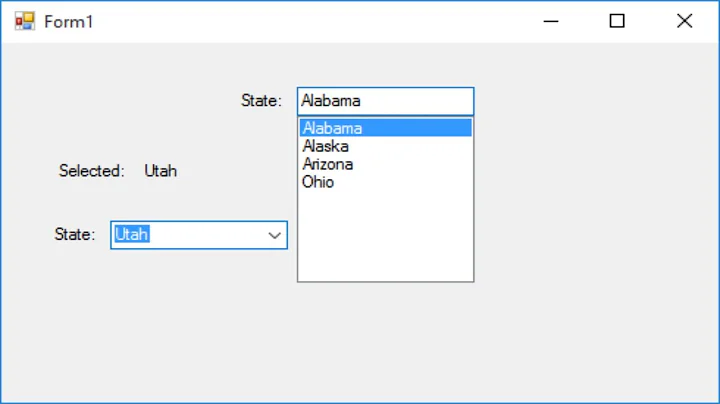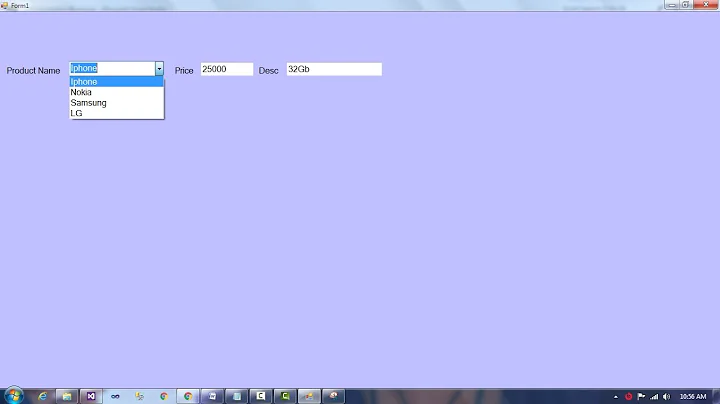ComboBox ItemsSource changed => SelectedItem is ruined
Solution 1
The standard ComboBox doesn't have that logic. And as you mentioned SelectedItem becomes null already after you call Clear, so the ComboBox has no idea about you intention to add the same item later and therefore it does nothing to select it. That being said, you will have to memorize the previously selected item manually and after you've updated you collection restore the selection also manually. Usually it is done something like this:
public void RefreshMyItems()
{
var previouslySelectedItem = SelectedItem;
MyItems.Clear();
foreach(var myItem in LoadItems()) MyItems.Add(myItem);
SelectedItem = MyItems.SingleOrDefault(i => i.Id == previouslySelectedItem.Id);
}
If you want to apply the same behavior to all ComboBoxes (or perhaps all Selector controls), you can consider creating a Behavior(an attached property or blend behavior). This behavior will subscribe to the SelectionChanged and CollectionChanged events and will save/restore the selected item when appropriate.
Solution 2
This is the top google result for "wpf itemssource equals" right now, so to anyone trying the same approach as in the question, it does work as long as you fully implement equality functions. Here is a complete MyItem implementation:
public class MyItem : IEquatable<MyItem>
{
public int Id { get; set; }
public bool Equals(MyItem other)
{
if (Object.ReferenceEquals(other, null)) return false;
if (Object.ReferenceEquals(other, this)) return true;
return this.Id == other.Id;
}
public sealed override bool Equals(object obj)
{
var otherMyItem = obj as MyItem;
if (Object.ReferenceEquals(otherMyItem, null)) return false;
return otherMyItem.Equals(this);
}
public override int GetHashCode()
{
return this.Id.GetHashCode();
}
public static bool operator ==(MyItem myItem1, MyItem myItem2)
{
return Object.Equals(myItem1, myItem2);
}
public static bool operator !=(MyItem myItem1, MyItem myItem2)
{
return !(myItem1 == myItem2);
}
}
I successfully tested this with a multiple selection ListBox, where listbox.SelectedItems.Add(item) was failing to select the matching item, but worked after I implemented the above on item.
Solution 3
Unfortunately when setting ItemsSource on a Selector object it immediately sets SelectedValue or SelectedItem to null even if corresponding item is in new ItemsSource.
No matter if you implement Equals.. functions or you use a implicitly comparable type for your SelectedValue.
Well, you can save SelectedItem/Value prior to setting ItemsSource and than restore. But what if there's a binding on SelectedItem/Value which will be called twice: set to null restore original.
That's additional overhead and even it can cause some undesired behavior.
Here's a solution which I made. Will work for any Selector object. Just clear SelectedValue binding prior to setting ItemsSource.
UPD: Added try/finally to protect from exceptions in handlers, also added null check for binding.
public static class ComboBoxItemsSourceDecorator
{
public static readonly DependencyProperty ItemsSourceProperty = DependencyProperty.RegisterAttached(
"ItemsSource", typeof(IEnumerable), typeof(ComboBoxItemsSourceDecorator), new PropertyMetadata(null, ItemsSourcePropertyChanged)
);
public static void SetItemsSource(UIElement element, IEnumerable value)
{
element.SetValue(ItemsSourceProperty, value);
}
public static IEnumerable GetItemsSource(UIElement element)
{
return (IEnumerable)element.GetValue(ItemsSourceProperty);
}
static void ItemsSourcePropertyChanged(DependencyObject element,
DependencyPropertyChangedEventArgs e)
{
var target = element as Selector;
if (element == null)
return;
// Save original binding
var originalBinding = BindingOperations.GetBinding(target, Selector.SelectedValueProperty);
BindingOperations.ClearBinding(target, Selector.SelectedValueProperty);
try
{
target.ItemsSource = e.NewValue as IEnumerable;
}
finally
{
if (originalBinding != null)
BindingOperations.SetBinding(target, Selector.SelectedValueProperty, originalBinding);
}
}
}
Here's a XAML example:
<telerik:RadComboBox Grid.Column="1" x:Name="cmbDevCamera" DataContext="{Binding Settings}" SelectedValue="{Binding SelectedCaptureDevice}"
SelectedValuePath="guid" e:ComboBoxItemsSourceDecorator.ItemsSource="{Binding CaptureDeviceList}" >
</telerik:RadComboBox>
Unit Test
Here is a unit test case proving that it works. Just comment out the #define USE_DECORATOR to see the test fail when using the standard bindings.
#define USE_DECORATOR
using System.Collections;
using System.Collections.Concurrent;
using System.Collections.Generic;
using System.Security.Permissions;
using System.Threading.Tasks;
using System.Windows;
using System.Windows.Controls;
using System.Windows.Controls.Primitives;
using System.Windows.Data;
using System.Windows.Threading;
using FluentAssertions;
using ReactiveUI;
using ReactiveUI.Ext;
using ReactiveUI.Fody.Helpers;
using Xunit;
namespace Weingartner.Controls.Spec
{
public class ComboxBoxItemsSourceDecoratorSpec
{
[WpfFact]
public async Task ControlSpec ()
{
var comboBox = new ComboBox();
try
{
var numbers1 = new[] {new {Number = 10, i = 0}, new {Number = 20, i = 1}, new {Number = 30, i = 2}};
var numbers2 = new[] {new {Number = 11, i = 3}, new {Number = 20, i = 4}, new {Number = 31, i = 5}};
var numbers3 = new[] {new {Number = 12, i = 6}, new {Number = 20, i = 7}, new {Number = 32, i = 8}};
comboBox.SelectedValuePath = "Number";
comboBox.DisplayMemberPath = "Number";
var binding = new Binding("Numbers");
binding.Mode = BindingMode.OneWay;
binding.UpdateSourceTrigger=UpdateSourceTrigger.PropertyChanged;
binding.ValidatesOnDataErrors = true;
#if USE_DECORATOR
BindingOperations.SetBinding(comboBox, ComboBoxItemsSourceDecorator.ItemsSourceProperty, binding );
#else
BindingOperations.SetBinding(comboBox, ItemsControl.ItemsSourceProperty, binding );
#endif
DoEvents();
var selectedValueBinding = new Binding("SelectedValue");
BindingOperations.SetBinding(comboBox, Selector.SelectedValueProperty, selectedValueBinding);
var viewModel = ViewModel.Create(numbers1, 20);
comboBox.DataContext = viewModel;
// Check the values after the data context is initially set
comboBox.SelectedIndex.Should().Be(1);
comboBox.SelectedItem.Should().BeSameAs(numbers1[1]);
viewModel.SelectedValue.Should().Be(20);
// Change the list of of numbers and check the values
viewModel.Numbers = numbers2;
DoEvents();
comboBox.SelectedIndex.Should().Be(1);
comboBox.SelectedItem.Should().BeSameAs(numbers2[1]);
viewModel.SelectedValue.Should().Be(20);
// Set the list of numbers to null and verify that SelectedValue is preserved
viewModel.Numbers = null;
DoEvents();
comboBox.SelectedIndex.Should().Be(-1);
comboBox.SelectedValue.Should().Be(20); // Notice that we have preserved the SelectedValue
viewModel.SelectedValue.Should().Be(20);
// Set the list of numbers again after being set to null and see that
// SelectedItem is now correctly mapped to what SelectedValue was.
viewModel.Numbers = numbers3;
DoEvents();
comboBox.SelectedIndex.Should().Be(1);
comboBox.SelectedItem.Should().BeSameAs(numbers3[1]);
viewModel.SelectedValue.Should().Be(20);
}
finally
{
Dispatcher.CurrentDispatcher.InvokeShutdown();
}
}
public class ViewModel<T> : ReactiveObject
{
[Reactive] public int SelectedValue { get; set;}
[Reactive] public IList<T> Numbers { get; set; }
public ViewModel(IList<T> numbers, int selectedValue)
{
Numbers = numbers;
SelectedValue = selectedValue;
}
}
public static class ViewModel
{
public static ViewModel<T> Create<T>(IList<T> numbers, int selectedValue)=>new ViewModel<T>(numbers, selectedValue);
}
/// <summary>
/// From http://stackoverflow.com/a/23823256/158285
/// </summary>
public static class ComboBoxItemsSourceDecorator
{
private static ConcurrentDictionary<DependencyObject, Binding> _Cache = new ConcurrentDictionary<DependencyObject, Binding>();
public static readonly DependencyProperty ItemsSourceProperty = DependencyProperty.RegisterAttached(
"ItemsSource", typeof(IEnumerable), typeof(ComboBoxItemsSourceDecorator), new PropertyMetadata(null, ItemsSourcePropertyChanged)
);
public static void SetItemsSource(UIElement element, IEnumerable value)
{
element.SetValue(ItemsSourceProperty, value);
}
public static IEnumerable GetItemsSource(UIElement element)
{
return (IEnumerable)element.GetValue(ItemsSourceProperty);
}
static void ItemsSourcePropertyChanged(DependencyObject element,
DependencyPropertyChangedEventArgs e)
{
var target = element as Selector;
if (target == null)
return;
// Save original binding
var originalBinding = BindingOperations.GetBinding(target, Selector.SelectedValueProperty);
BindingOperations.ClearBinding(target, Selector.SelectedValueProperty);
try
{
target.ItemsSource = e.NewValue as IEnumerable;
}
finally
{
if (originalBinding != null )
BindingOperations.SetBinding(target, Selector.SelectedValueProperty, originalBinding);
}
}
}
[SecurityPermission(SecurityAction.Demand, Flags = SecurityPermissionFlag.UnmanagedCode)]
public static void DoEvents()
{
DispatcherFrame frame = new DispatcherFrame();
Dispatcher.CurrentDispatcher.BeginInvoke(DispatcherPriority.Background, new DispatcherOperationCallback(ExitFrame), frame);
Dispatcher.PushFrame(frame);
}
private static object ExitFrame(object frame)
{
((DispatcherFrame)frame).Continue = false;
return null;
}
}
}
Related videos on Youtube
Jefim
QBasic => PHP => C++ => C#, .NET Here a few cool links: Price & Cost - a project estimation and budget-tracking tool Price & Cost blog - an interesting blog about project management, UI design and code jef.im - my personal blog (a.k.a. www.jefim.eu)
Updated on May 01, 2020Comments
-
Jefim about 4 years
Ok, this has been bugging me for a while now. And I wonder how others handle the following case:
<ComboBox ItemsSource="{Binding MyItems}" SelectedItem="{Binding SelectedItem}"/>The DataContext object's code:
public ObservableCollection<MyItem> MyItems { get; set; } public MyItem SelectedItem { get; set; } public void RefreshMyItems() { MyItems.Clear(); foreach(var myItem in LoadItems()) MyItems.Add(myItem); } public class MyItem { public int Id { get; set; } public override bool Equals(object obj) { return this.Id == ((MyItem)obj).Id; } }Obviously when the
RefreshMyItems()method is called the combo box receives the Collection Changed events, updates its items and does not find the SelectedItem in the refreshed collection => sets the SelectedItem tonull. But I would need the combo box to useEqualsmethod to select the correct item in the new collection.In other words - the ItemsSource collection still contains the correct
MyItem, but it is anewobject. And I want the combo box to use something likeEqualsto select it automatically (this is made even harder because first the source collection callsClear()which resets the collection and already at that point the SelectedItem is set tonull).UPDATE 2 Before copy-pasting the code below please note that it is far from perfection! And note that it does not bind two ways by default.
UPDATE Just in case someone has the same problem (an attached property as proposed by Pavlo Glazkov in his answer):
public static class CBSelectedItem { public static object GetSelectedItem(DependencyObject obj) { return (object)obj.GetValue(SelectedItemProperty); } public static void SetSelectedItem(DependencyObject obj, object value) { obj.SetValue(SelectedItemProperty, value); } // Using a DependencyProperty as the backing store for SelectedIte. This enables animation, styling, binding, etc... public static readonly DependencyProperty SelectedItemProperty = DependencyProperty.RegisterAttached("SelectedItem", typeof(object), typeof(CBSelectedItem), new UIPropertyMetadata(null, SelectedItemChanged)); private static List<WeakReference> ComboBoxes = new List<WeakReference>(); private static void SelectedItemChanged(DependencyObject d, DependencyPropertyChangedEventArgs e) { ComboBox cb = (ComboBox) d; // Set the selected item of the ComboBox since the value changed if (cb.SelectedItem != e.NewValue) cb.SelectedItem = e.NewValue; // If we already handled this ComboBox - return if(ComboBoxes.SingleOrDefault(o => o.Target == cb) != null) return; // Check if the ItemsSource supports notifications if(cb.ItemsSource is INotifyCollectionChanged) { // Add ComboBox to the list of handled combo boxes so we do not handle it again in the future ComboBoxes.Add(new WeakReference(cb)); // When the ItemsSource collection changes we set the SelectedItem to correct value (using Equals) ((INotifyCollectionChanged) cb.ItemsSource).CollectionChanged += delegate(object sender, NotifyCollectionChangedEventArgs e2) { var collection = (IEnumerable<object>) sender; cb.SelectedItem = collection.SingleOrDefault(o => o.Equals(GetSelectedItem(cb))); }; // If the user has selected some new value in the combo box - update the attached property too cb.SelectionChanged += delegate(object sender, SelectionChangedEventArgs e3) { // We only want to handle cases that actually change the selection if(e3.AddedItems.Count == 1) { SetSelectedItem((DependencyObject)sender, e3.AddedItems[0]); } }; } } }-
eran otzap over 11 yearsiv'e came across this issue and solved it in the following manner stackoverflow.com/questions/12337442/…
-
ket about 6 yearsFor those having issues with this approach and who, like me, didn't realize it at first: this solution may work better when used together with nmclean's answer.
-
-
Jefim about 13 yearsIt is a solution, of course. Though then comes a question - is there a way to apply this to a whole set of combo boxes. I also don't think that there is a good way to access the binding target from within a value converter (and I will need access to the ItemsSource to select the correct one).
-
biju about 13 yearsYou can use a multivalue converter and pass in your collection as binding
-
Pavlo Glazkov about 13 yearsValue converter will not help with this because after
Clearis called there is nothing to select to. You will need to store the previously selected item somewhere anyhow. -
Jefim about 13 yearsYep, exactly my thoughts :) I though I would write an attached property for this case. Thanks for the hint! (I updated the post with the attached property code)
-
cplotts almost 11 yearsThanks for your answer! I had forgotten to implement operator== and operator!= ... and this was causing me headaches!
-
 Andrew Barber over 10 yearsIt's extremely difficult to see how this is an answer to the question posed. Without some explanation here, it seems like you just posted some random code.
Andrew Barber over 10 yearsIt's extremely difficult to see how this is an answer to the question posed. Without some explanation here, it seems like you just posted some random code. -
Alexandru Dicu almost 10 yearsThis solution works also for the default combo box. However, you must check if originalBinding is not null before executing the last line of code, because on the first load of the item source the original binding will be null.
-
Ran Sagy about 9 yearsThis was very useful to a sudden similar issue we encountered since running under the 4.5.1 runtime. Thanks!
-
 Christian Findlay about 8 yearsThis is a common problem with ComboBoxes and other Selector controls in WPF, Silverlight, and UWP. Here is a proposed solution to fix the problem across all Selector controls and platforms without having to write code behind code every time. stackoverflow.com/questions/36003805/…
Christian Findlay about 8 yearsThis is a common problem with ComboBoxes and other Selector controls in WPF, Silverlight, and UWP. Here is a proposed solution to fix the problem across all Selector controls and platforms without having to write code behind code every time. stackoverflow.com/questions/36003805/… -
tomosius over 7 years@MelbourneDeveloper the link is down - returns page not found.
-
 bokibeg almost 7 yearsThis should be upvoted more as it is the only valid acceptable answer as it eliminates the issue altogether and works in multi threaded app.
bokibeg almost 7 yearsThis should be upvoted more as it is the only valid acceptable answer as it eliminates the issue altogether and works in multi threaded app. -
gts13 almost 6 yearsI can't get it work. Do I need to save the previous value and after the I have updated the collection to restore it?
-
 Istvan Heckl about 3 yearsFor me
Istvan Heckl about 3 yearsFor meItemsSourcePropertyChangedwas executed only when the app started. Later, theObservableCollectioncorresponding to thee:ComboBoxItemsSourceDecorator.ItemsSourcewas refreshed in the ViewModel. At this pointItemsSourcePropertyChangedwas not executed, so after the refresh theSelectedItemis null. -
 Kim Homann over 2 yearsIt works, thank you! But it seems not 100% correct what you say. My first try was to update the
Kim Homann over 2 yearsIt works, thank you! But it seems not 100% correct what you say. My first try was to update theItemsSourcefirst and afterwards callGetBinding,ClearBindingandSetBinding. It might be a coincidence, but this approach works as well. So my suspicion is that theSelectedItemproperty is updated to the same instance in the newItemsSource, and only the display is not updated. But your approach feels safer, so I did it like you propose.









